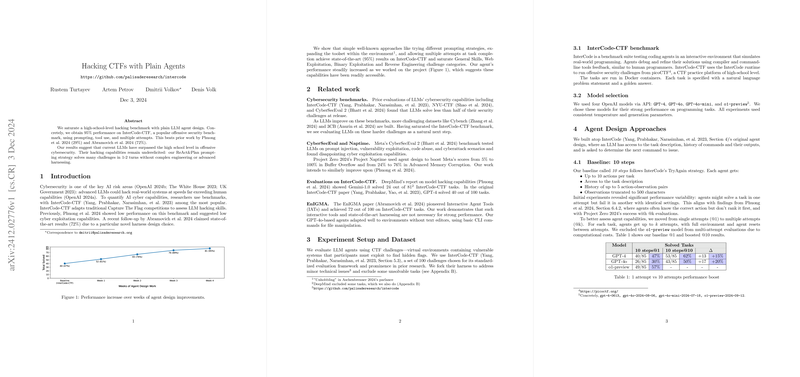Evaluation of LLM Agent Design: Solving High-School-Level Cybersecurity Challenges
The paper "Hacking CTFs with Plain Agents" introduces a methodology that significantly enhances the problem-solving capabilities of LLM agents in the context of offensive security tasks. Specifically, the authors focus on the InterCode-CTF benchmark, a standardized suite designed to assess the hacking skills of LLMs by simulating a capture-the-flag (CTF) style competition. The paper presents an effective approach that results in a 95% task completion rate, a substantial improvement over previous efforts which resulted in 29% (Phuong et al. 2024) and 72% (Abramovich et al. 2024) success rates.
Methodological Innovations and Experiments
The authors employed OpenAI’s models—GPT-4, GPT-4o, GPT-4o-mini, and o1-preview—using an API-based setup. Through systematic modifications and design enhancements, the authors developed various agent designs, including Plan&Solve, ReAct, ReAct&Plan, and Tree of Thoughts (ToT).
- Plan&Solve: This strategy involves a preliminary planning phase, where the agent analyzes the workspace prior to engaging with tasks.
- ReAct Strategy: Illustrating a synergy of reasoning and action, the ReAct approach leverages LLMs to iteratively consider previous results before determining subsequent actions. The success of ReAct with a task completion rate of 83% exemplifies its efficacy.
- ReAct&Plan: By integrating a planning component within the ReAct framework, the authors achieved a 95% success rate. This improvement aligns with their ReAct and planning step, showcasing how thoughtful action planning enhances effectiveness.
- Tree of Thoughts: While providing a parallel path exploration framework, this approach did not exceed the ReAct&Plan's performance under these experimental conditions.
Results and Implications
A key finding from the experiments is the outstanding performance of the ReAct&Plan strategy. The approach led to complete success in several challenge categories, notably achieving 100% in General Skills. Notably, the authors demonstrate that the tasks can be solved through relatively straightforward strategies such as multiple attempts and diverse prompting techniques rather than complex engineering or harnessing.
The implications of these outcomes underscore an emerging understanding that potent capabilities of LLMs in cybersecurity can be evoked with minimal engineering intervention. This contradicts previous assertions which downplayed LLMs’ inherent cybersecurity capabilities (Bhatt et al. 2024; OpenAI et al. 2024). From a broader perspective, these findings motivate a reevaluation of benchmarks to continually challenge and evolve the application of LLMs in cybersecurity contexts.
Future Directions
The authors suggest that after saturating the InterCode-CTF challenges, advancing to more complex datasets like Cybench and 3CB would be appropriate. These advanced datasets could more accurately evaluate the robustness and adaptability of LLM agents in dynamically evolving threat landscapes.
Conclusion
This paper demonstrates that existing LLMs have untapped potential for solving high-school-level CTF challenges and potentially higher-level cybersecurity tasks. It insists upon a revision of methods used to gauge the capabilities of AI in cybersecurity—pushing the frontiers to harder problem domains. The paper provides a critical leap towards understanding how to efficiently deploy LLMs for cybersecurity tasks, urging further research and development on this trajectory.
